Modality Preferences
A Note on Modality Terminology & Practice
At EDUCAUSE, we recognize that higher education stakeholders have not come to a consensus on the way instructional modalities are labeled and operationalized. People have different definitions and understandings of courses that are labeled as "online," "online synchronous," "online asynchronous," "hybrid," "blended," "HyFlex," and "in-person." While it was beyond the scope of this study to perform a deep dive into the nuances of modalities, we felt it was important to assess the extent to which instructional modalities included remote or on-site and synchronous or asynchronous components, and whether technology was used to support teaching and learning. Thus, we used the Revised Modes of Learning Spectrum to ask about modality preferences and teaching experiences across modalities.1 This framework is based on research showing that most teaching and learning experiences fall into three broad categories of modalities: online, hybrid, and in-person technology-supported learning. Throughout this report, we use the term "on-site" to describe courses that take place on-campus (aka, in-person or face-to-face) and "online" to describe courses held remotely from a space outside of the classroom.
On-site teaching remains the modality preferred by most faculty. A slim majority of faculty (53%) prefer to teach on-site, but almost all of these faculty nonetheless like to use technology to support their in-person teaching (see figure 1).2 When it comes to online and hybrid teaching, 18% of respondents said they prefer teaching courses that are completely online, and 20% prefer teaching hybrid (i.e., a course that includes a mix of online and on-site instruction). In comparison, in 2019 73% of faculty preferred teaching mostly or completely on-site, while 9% preferred teaching completely online.3 Thus, while there has been a shift in modality preferences, the overall pattern remains similar to pre-pandemic findings—the most preferred mode of teaching is still on-site, and the least preferred is online.
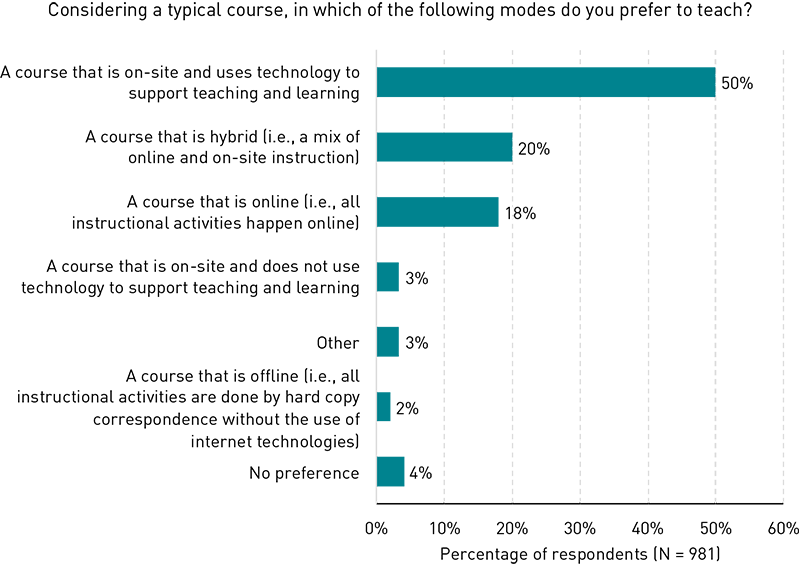
Faculty prefer to teach all of their courses in the same mode. We also asked faculty about their preferences for modality when teaching multiple courses during an academic term. A majority (68%) said that they prefer to teach all of their courses in a single modality within a term, while 25% prefer teaching using a combination of modes (see figure 2). The preference for teaching multiple courses in the same mode may stem from a phenomenon akin to code switching, which is when an individual alternates between languages or dialects within a conversation. Code switching is something that can be easier for some than others.

We asked respondents about how easily they are able to switch between instructional modalities within an academic term (aka "mode switching"). Only 21% said that it is easy or very easy to switch between modalities. Further, we examined the ease of mode switching broken down by preferences for teaching multiple courses in a typical term. Of the faculty who prefer to teach all of their courses in the same mode, 51% said that mode switching is extremely or slightly difficult as compared to those who prefer to teach in a combination of modes (30% said mode switching is difficult) (see figure 3). Thus, the preference for teaching multiple courses in the same modality may be due to the increased difficulty that goes along with switching between modalities.

Hybrid and online modalities are more flexible and offer greater support. We asked faculty to select from a list their reasons for their modality preferences. We broke these findings down by preferred teaching modality. Faculty who prefer teaching online and hybrid courses indicated that these modes are more flexible for themselves and their students as compared to on-site courses (see figure 4).4 Those who preferred online teaching were more likely to already have prepared classes in that mode and to have more support for instructional technology and instructional design than those teaching on-site or hybrid courses.
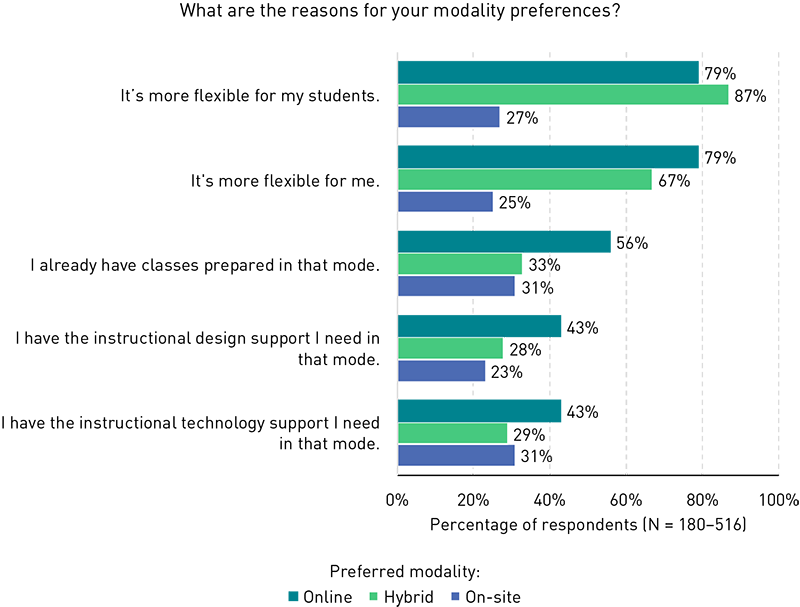
Reasoning for preferences is nuanced—each modality brings its own affordances. Approximately 12% of respondents indicated "other" reasons for their modality preferences. Based on open-ended comments, we found that in addition to the ability to read the room and increased student engagement, a number of other factors were driving faculty preferences for on-site teaching, such as how well content does or doesn't translate to online settings and the ease of building community and relationships.5
My classes focus on plant identification in the field. My students must be outside with me to learn the plants.
Complexity and nuance often fail to get transferred online, no matter how intensive your pedagogy.
I prefer face-to-face, given the nature of the course material. Observing non-verbals helps me "read" the class, their reactions, and their understanding of the material.
I think it offers more opportunities to build relationships (teacher–student and student–student).
For faculty who prefer to teach online or in hybrid mode, flexibility (for both faculty and students) plays a significant role. But a number of other factors such as faculty and student health and safety, accessibility, and equity also are important. Overall, differences in faculty preferences for teaching modality may be driven by the importance placed on factors inherent in different modalities. These findings also illustrate that no single modality is clearly the best in all circumstances. Rather, each modality brings unique benefits and challenges that need to be considered as institutions decide how to better support teaching and learning.
I am an adjunct, so [I] need to be able to do all teaching during "off hours." Online is the best mode for that.
I am a sole faculty department, so having flexibility of online days allows me to provide the teaching interaction I expect for my students.
It's the only way I can come up with that doesn't incentivize students to come to class sick or put immunocompromised students at risk.
COVID, school shootings, and flexibility of schedule for everyone involved.
It is equitable. Students who are parents can easily participate.
It allows for students who work or miss class to keep up.
Faculty feel that on-site courses promote better outcomes. We asked faculty to rate teaching and learning outcomes based on teaching modality (i.e., when they teach fully on-site versus hybrid versus fully online). Across the board, faculty felt that teaching and learning outcomes were better when teaching on-site versus either hybrid or online (see figure 5). Specifically, a majority of faculty felt more connected to and able to engage their students when teaching on-site (91% and 89%, respectively) as compared to teaching online (39% and 48%) or hybrid courses (61% and 62%). Additionally, faculty felt that the quality of their teaching is best and that their students learn the most when teaching on-site (83% and 70%, respectively) as compared to teaching online (43% and 27%) or hybrid courses (54% and 47%).
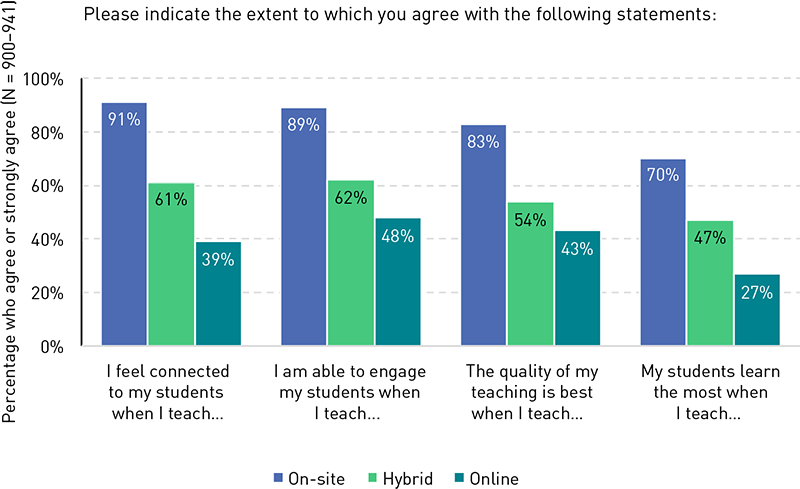
Not all faculty have a choice when it comes to teaching modality. We asked faculty what mode they currently are primarily teaching in. We found that currently, 45% of faculty primarily teach on-site, 23% teach in a combination of modes, 20% teach online, and 10% teach in hybrid mode. A majority of respondents (65%) said that they are currently teaching in their preferred modes (see figure 6). A number of those who selected "other" indicated that they teach only some courses in their preferred mode(s), given that they teach multiple courses in different modalities.

We looked further into these results to see whether there were any significant discrepancies between preferred modality and current teaching modality. A majority of those who prefer to teach on-site or online are currently teaching in their preferred mode (70% and 71%, respectively). However, only 44% of those who prefer to teach hybrid courses said they are currently doing so. For faculty not teaching in their preferred modes, the number one reason was that they don't have a choice; 59% indicated that they are required to teach certain courses in certain modes (see figure 7). Surprisingly, the second most common reason selected was "other" (42%).
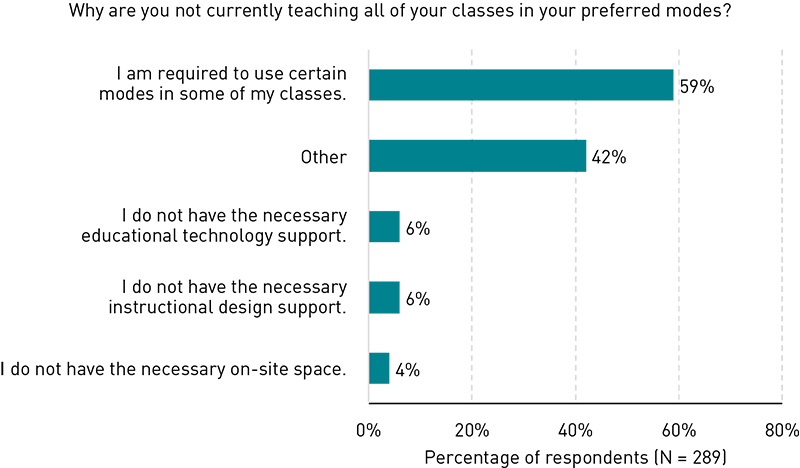
Faculty will teach in non-preferred modes to meet their students' needs. We asked the 42% of individuals who selected "other" to specify their reasons for not teaching in their preferred modes. While many of these respondents also noted a lack of choice, (i.e., requirements, some courses are not offered in certain modes, some content only works in certain modes), they also illustrated the willingness of faculty to teach in non-preferred modes in order to accommodate students and extenuating life circumstances. Below are a few comments highlighting this theme:
This past semester I only taught one course, which I designed to be fully in-person. Following a campus tragedy, I made the course hybrid (synchronous with some students in person and some online) to give more grace and flexibility to students having a difficult time returning to campus.
Some students need [courses] to be hybrid still, so I do it for my students.
The class I teach now works better for students in the all-online format as it is an internship that can be done off campus, out of state, or out of the country.
Teaching in non-preferred modes more strongly impacts faculty who prefer to teach on-site. We asked faculty to identify the impacts of teaching in non-preferred modes in two areas: teaching and student outcomes. The most common teaching impacts were that it makes teaching less enjoyable (46%) and increases stress (44%). The most common student impacts were lower engagement (55%) and decreased learning (37%). We also broke these findings down by preferred teaching modality (see figure 8 for impact on teaching and figure 9 for impact on students). Notably, the findings that teaching in non-preferred modes is less enjoyable and that teaching quality suffers are largely driven by those who prefer to teach on-site, while stress was a common impact regardless of preferred modality. The greater impact on enjoyment and teaching quality for those who prefer to teach on-site may be related to a decreased ability to foster student engagement and connectedness in other modalities, two dimensions of teaching that, as noted above, are particularly prized by faculty whose preference is to teach in-person.
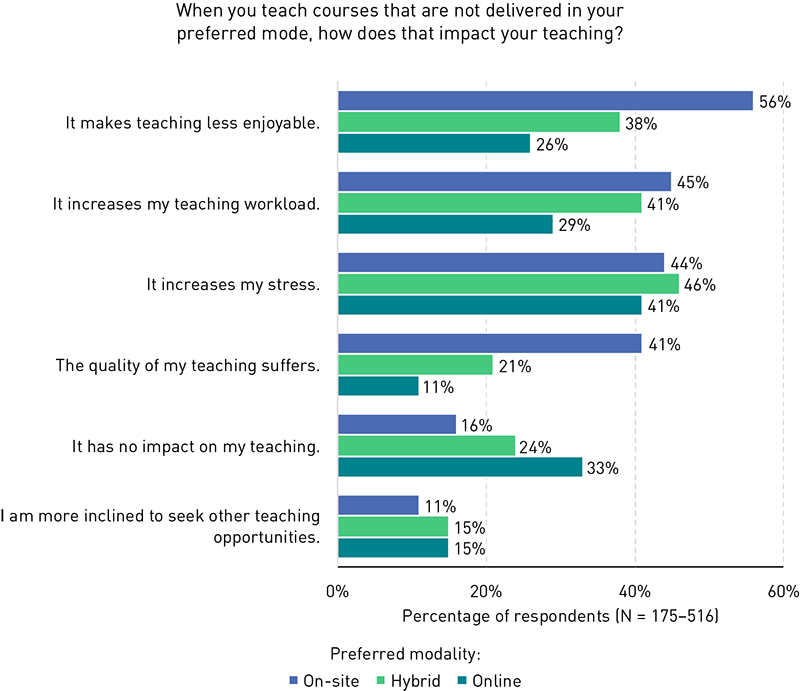
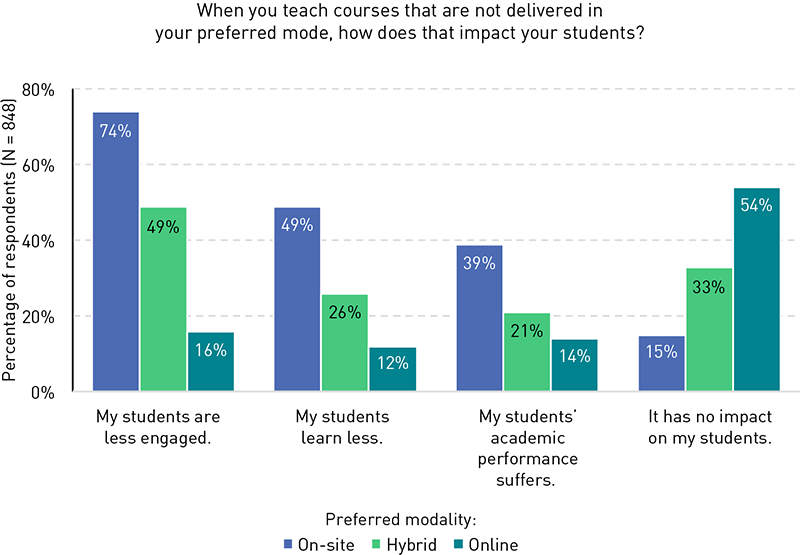
Notes
-
Nicole Johnson, Jeff Seaman, and Russ Poulin, "Defining Different Modes of Learning: Resolving Confusion and Contention Through Consensus," Online Learning 26, no. 3 (2022): 91–110.
↩︎ -
Percentages throughout have been rounded to the nearest whole number, occasionally resulting in sums just under or over 100%.
↩︎ -
The survey items measuring modality preferences were not the same in 2019 and 2023, so only general comparisons can be made.
↩︎ -
In figures 4, 5, 8, and 9, we only show findings for three modality preferences: those who prefer to teach on-site, hybrid, and online courses. The percentages for other modalities were much lower and were thus excluded from these comparisons.
↩︎ -
Open-ended data has been reported verbatim except for light editing for readability (e.g., typos and punctuation).
↩︎